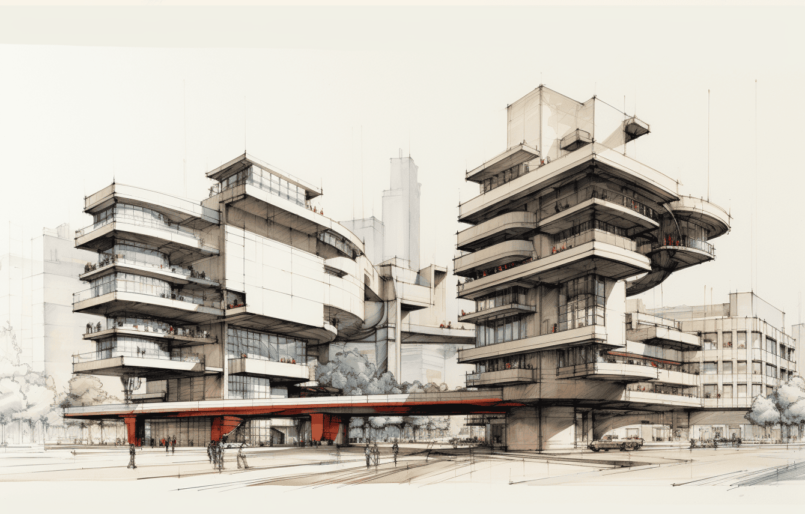Introduction
Architectural visualization plays a pivotal role in the design process, allowing architects and designers to effectively communicate their ideas to clients and stakeholders. Over the years, the field of architectural visualization has witnessed a remarkable evolution, transitioning from the charm of hand-drawn sketches to the awe-inspiring world of photorealistic digital renderings and immersive virtual reality experiences. This article explores the fascinating journey of architectural visualization techniques, from its humble beginnings to the cutting-edge technologies of today….
The Age of Hand-Drawn Sketches
Before the digital era, architectural visualization relied on the artistic skill of hand-drawn sketches. Architects would meticulously create sketches to convey their design concepts to clients and stakeholders. These sketches captured the essence of the vision, showcasing the raw creativity of the architect’s mind. While lacking the precision of digital renderings, hand-drawn sketches had a unique charm and an emotive quality that resonated with clients on a personal level.
Emergence of Digital Rendering
The advent of digital technology revolutionized architectural visualization. Computer-aided design (CAD) software empowered architects to create precise and detailed 2D and 3D models of their designs. This transition from traditional methods allowed architects to visualize their designs in three dimensions, offering a more comprehensive understanding of spatial relationships. Digital rendering techniques enabled architects to transform these models into realistic visualizations, incorporating materials, lighting, and textures. This marked a significant departure from hand-drawn sketches and opened up new possibilities for design exploration and communication.
Photorealism and Beyond
The pursuit of realism led to the development of photorealistic rendering techniques. Advancements in graphics processing and rendering software allowed architects to create images that closely resembled photographs of real spaces. These highly detailed renderings captured the finest nuances of materials, lighting, and textures, providing clients with a realistic preview of the final project. The impact of photorealistic renderings cannot be overstated, as they became indispensable tools for obtaining approvals, securing funding, and marketing architectural projects.
Rise of Virtual Reality (VR)
The integration of virtual reality into architectural visualization brought a paradigm shift in how designs were experienced. Virtual reality (VR) technology creates immersive virtual environments, allowing users to navigate and explore architectural spaces as if they were physically present. Architects and clients can now experience designs at a human scale before construction even begins, enhancing communication and understanding. VR also aids in identifying potential design flaws and optimization opportunities early in the process, reducing costs and delays down the line.
Interactive Walkthroughs and Real-Time Visualization
Advancements in real-time rendering have introduced the concept of interactive walkthroughs. Architects and clients can navigate through virtual spaces in real-time, making design decisions on the spot. This level of interactivity enhances collaboration and accelerates the decision-making process. Real-time rendering also facilitates experimenting with different lighting scenarios, materials, and design alternatives, empowering architects to fine-tune their designs with greater precision. Clients can now actively participate in the design process, providing feedback and making informed decisions based on their virtual experiences.
Sustainability Visualization
As sustainability becomes increasingly important in architecture, visualization techniques have adapted accordingly. Modern visualization tools allow architects to simulate the environmental performance of buildings, showcasing concepts like energy efficiency, solar exposure, and airflow. By integrating environmental factors into renderings, architects can communicate the sustainable aspects of their designs to clients and stakeholders. This fosters a more informed discussion about energy efficiency, resource conservation, and the overall environmental impact of architectural projects.
Integration of Artificial Intelligence (AI) and Machine Learning
Artificial intelligence (AI) and machine learning are making their way into architectural rendering, bringing new possibilities and efficiencies. AI algorithms can analyze vast datasets of architectural designs and preferences, providing automated suggestions and generating design alternatives based on predefined parameters. Machine learning algorithms can assist in rendering by accelerating rendering times, reducing noise, and optimizing lighting and material settings. This integration of AI and machine learning in rendering software improves productivity, enhances the quality of renderings, and opens up opportunities for design exploration and optimization.
The Future of Architectural Visualization
The future of architectural visualization is poised for further advancements as technology continues to evolve. As processing power increases and software capabilities expand, we can expect even more realistic and immersive visualizations. Virtual reality experiences will become more accessible and refined, allowing for even greater design collaboration and client engagement. Additionally, the integration of artificial intelligence and machine learning will continue to enhance the speed and quality of renderings, enabling architects to explore design alternatives more efficiently.
Finally
The evolution of architectural visualization has revolutionized the way architects and designers communicate their ideas. From the charm of hand-drawn sketches to the photorealistic wonders of digital renderings and immersive virtual reality experiences, architectural visualization techniques have continually pushed the boundaries of what is possible. As technology continues to advance, architectural visualization will continue to play a vital role in the design process, empowering architects to bring their visions to life and create memorable spaces for generations to come.
For more information on architectural visualization and the latest trends, visit link.


